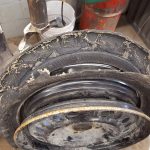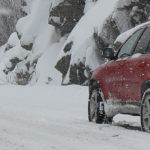Michelin Offers Tire-Related Safety Tips Ahead Summer Travel Season
Tire manufacturer Michelin has assembled a list of tips that can contribute to safe driving this warm-weather travel season, as well as every other day of the year.
Michelin Canada encourages drivers to minimize the risk of on-road emergencies simply by preparing ahead of time, conducting proper safety checks, and adhering to safe driving tips. And remember– something as simple as a quick circle check of your ride before setting off can reveal plenty of potential problems, tire-related and otherwise.
Here’s a closer look.
Check Your Tires
Tires are the only part of the vehicle that touches the road. As such, regular checks can be a big step towards safety and confidence on the go.
- Check for wear – Using the ‘Penny Test,’ put the edge of the coin into the tread with the Queen going in head first. If the top of the Queen’s head is covered by tread, you’re safe. If the top of her head is entirely visible, it’s time to replace the tire.
- Check the air pressure – Tires have been known to lose up to 1 psi (pounds per square inch) of pressure every month. Use a proper pressure gauge to check pressure when tires are ‘cold’ (before driving, or three hours after driving). Make sure your tires are inflated to the psi on the sticker inside the driver’s door of your car. DO NOT compare to the psi on your tire’s sidewall.
- Don’t mix tires – If you’re replacing only two new tires instead of four, be sure they are the same size and type as the current ones. Install the new tires on the rear axle of your vehicle, which will reduce the risk of fishtailing and loss of stability in wet conditions.
Wet Driving
Wet roads pose a potential hazard, as reduced traction means longer stopping distances are required. Additionally, vehicle brake and steering don’t react the same way on a wet road as they do when it’s dry. As such, remember:

- Slow down before turning and maintain a consistent speed throughout the turn. Sudden steering inputs can cause a loss of control—so be sure to be smooth with the wheel while cornering on a wet road. Only brake in a straight line before the turn, and do so gradually. Do not brake during the turn.
- If hydroplaning, do not accelerate or brake suddenly. Keep your foot lightly on the gas and steer the car forward until your tires regain traction.
- Slowing down dramatically decreases the risk of accidents in rain. Ditto keeping two hands on the steering wheel at all times.
Blowouts
A tire blowout can be one of the most frightening moments a driver will ever face. Remember the following.
- If you have a tire blowout, don’t panic. The loud noise will startle you, but follow these rules, and you’ll quickly and safely regain control. First, keep your foot on the gas, grip the wheel firmly and stay in your lane, then, slow down gradually and carefully steer toward the shoulder of the road.
- Having two hands on the wheel will allow drivers to more easily maintain vehicle control, even after a blowout.
- Blowouts can be caused by a variety of factors, including poor tire maintenance and improper inflation pressure. Regular checks of tire pressure and condition are, thus, important as a pre-emptive precaution against blowouts.
For more tips on safe driving, visit http://www.michelin.ca/tires-101/driving-and-safety-tips/driving-tips.page





